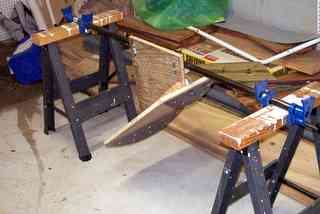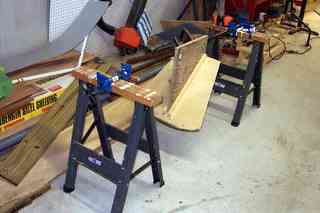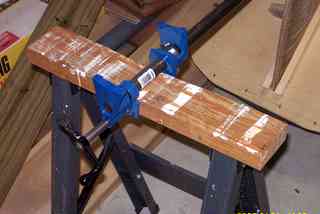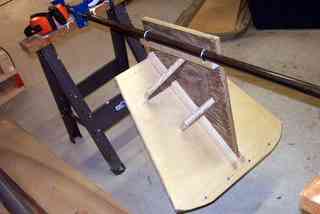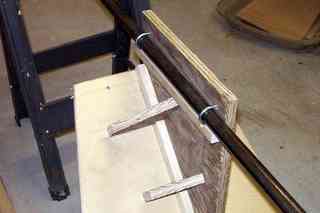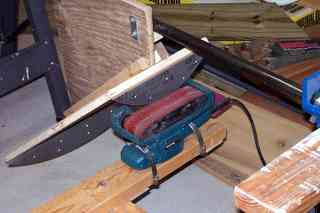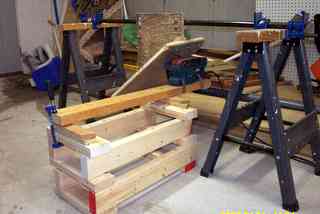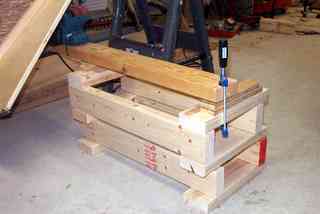Click on the pictures to see a larger view -- use your browser BACK button to return to this page.
These first three pictures show an overview of the clamp with two sets of fittings and the details of one of the sets.
This is the top side of the Equatorial Platform's table (the sector arcs being machined are on the other side) and the picture shows the general layout of the jig and table. The jig fitting was retained to serve for polar alignment, as the direction of the clamp's pipe is exactly parallel to the platform's polar axis of rotation.
Just a closer look at the U-bolts that held the jig and table to the pipe clamp, and permitted rotation.
From a lower angle, we see the south sector, made of 1/4 inch (6 mm) thick aluminum. (I won't say aluminium again... you'll have to run this through Babelfish if you don't understand ;-))
The same components seen "end on" through one of
the sawhorses. As the jig and table are rocked from
side to side, the belt sander removes any out-of-round
spots and leave it smooth and sharp. In fact, you may
well want to take the sharp edges off the aluminum
plate after machining.
I simply clamped my Makita belt sander to a length
of 2x4 lumber using hose clamps.
I used a woodworking "C-clamp" to provide a controlled
way to apply upward pressure on the belt sander. It
only takes a little. If I were doing this again, I'd
use a carriage bolt and wing nut instead of the clamp,
which tended to fall off once in a while.
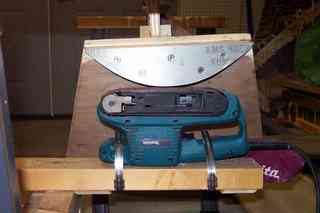 These last two pictures show the support I built (one
more 2x4 chopped up to make the structure) that holds
the belt sander steadily.
These last two pictures show the support I built (one
more 2x4 chopped up to make the structure) that holds
the belt sander steadily.
My Equatorial Platform
Background
Chuck Shaw, Warren Peters and most other builders of Equatorial Platforms used a similar technique to produce the smooth and precise curves needed for the sector arcs. Each of them, however, arranged the axis of rotation for their arc machining in a vertical orientation.
I have a moderate collection of woodworking equipment, and thought that using pipe clamps for my rotation axis. By placing a second set of clamp fittings on the pipe, I had two clamps to secure the pipe to the top of two sawhorses.
The key to economy in these kinds of things is to use what you've already acquired, although there are any number of projects I've undertaken that just NEEDED a special tool. In this case, a rotary sanding disk chucked into an electric drill, although needing a different kind of mounting, would have accomplished the same result.
The sector machining is the key to the operation of an Equatorial Platform, but it's not as hard as it looks. Study Shaw's and Peters' papers and other materials at the Yahoo Equatorial Platforms group and you'll have no trouble.
Cautions...
I ground a volume of about 1/8 inch by 1/4 inch by 30 inches or 3 x 6 x 75 mm of aluminum to dust in this process. You should notice on one of the sawhorses that I have eye, ear, and respiratory protection that should be used whenever you're doing this kind of work, whether in metal or wood.
I also had the jig and sawhorses located over by the open shop door with a box fan blowing out the door as well. I did this to try to keep the dust away from me and my shop.
